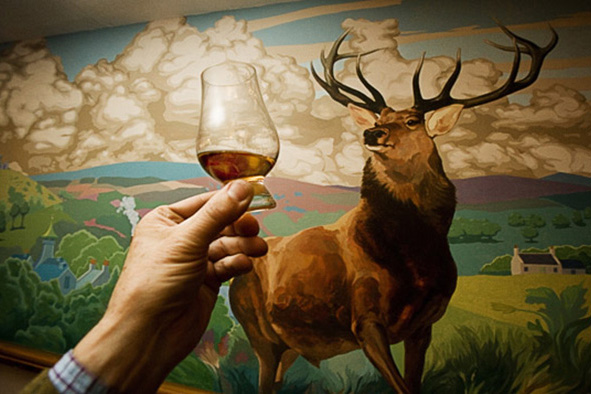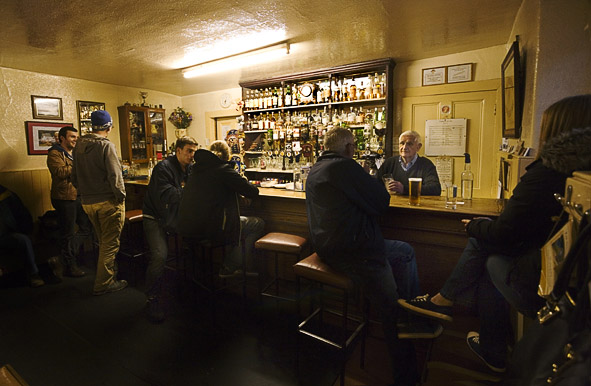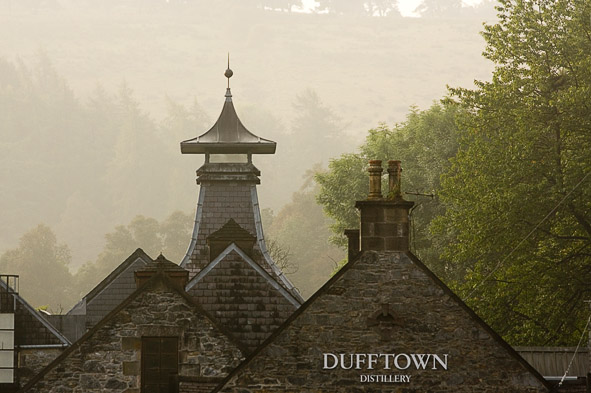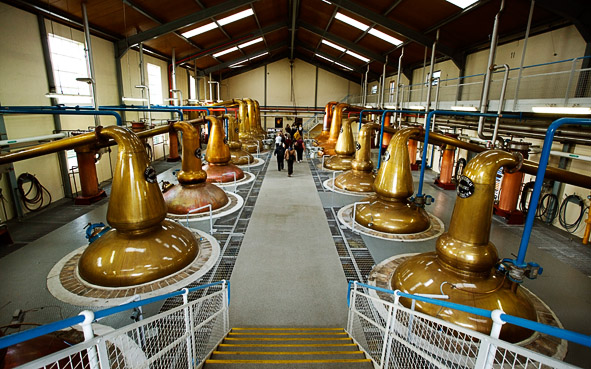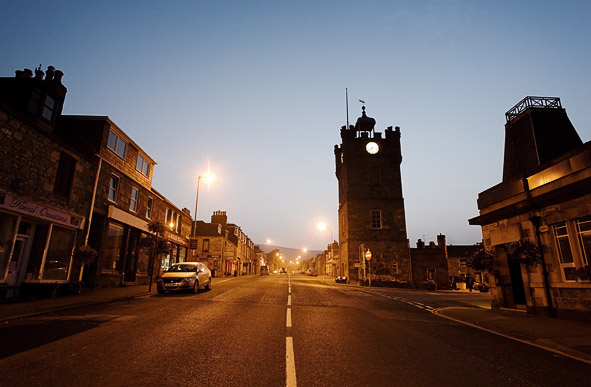Single malt or blended, Scotch whisky is well known and well loved worldwide. The rolling, verdant hills of Speyside are home to the largest concentration of whisky distilleries in Scotland. Dufftown is the de facto capital of this whisky land, but a trip there is a far more refined experience than one would expect.
Fiddichside
“A wee dram of Craigellachie laddie” said the man with a mane of grey hair as he perched on a barstool. I was still in Britain; Scotland’s North East to be exact. And I had no idea what he just said.
The man tending the bar, Joe, poured the whisky into a tumbler. He has run Fiddichside Inn near Craigellachie for five decades; his parents-in-law ran it for four decades before that. Ironically Joe’s surname is Brandy, but the Craigellachie whisky distillery is so close that they could roll barrels down to the Fiddichside Inn if they wanted to. Joe, a former cooper, could even have made the barrels himself. This is the heart of Speyside, aka whisky country.
Nestled beside the River Fiddich, the pub is just metres above the confluence with the River Spey, from whence many a Speyside dram is conceived. There are roughly fifty whisky distilleries in this area.
Fiddichside Inn looks more like a school tuck shop than a bar. With ten people inside it was a cosy squeeze. The bar ran the length of the cream-walled room and took up half the width. The shelves behind contained a collection of whisky bottles all equally priced.
I had a single malt Craigellachie: my first taste of the local produce. It was a light, even rather sweet, dram typical to the region; qualities that set Speyside whisky apart from the smoky flavours of the peat influenced whiskies produced in the Highlands.
Festivals in Whiskyland
If borders could be redrawn by alcoholics, Dufftown would be the capital of Whiskyland. There would be a pilgrimage there every year. As a matter of fact, there are two per year, as the town hosts spring and autumn whisky festivals. The Spirit of Speyside Whisky Festival takes place during the first days of May each year. It is akin to paradise for whisky lovers.
Middle aged men sleeping in flower beds and vomit splash reupholstering. These were both things I had expected from a town known as the world’s whisky capital. But weekends in Dufftown are far more refined, much like the whisky I had begun to sample.
Earlier that day I caught up with Steve, who helps run the Autumn Speyside Whisky Festival. In fact we were talking over a cup of coffee – even connoisseurs need to take a break from time to time.
“We run about 90 events during the autumn festival” Steve said.
“Is the Spring Spirit of Speyside Festival similar?” I asked.
“It’s a lot bigger. I would say it is more a tourist event, whilst the autumn festival attracts more hardened whisky connoisseurs.”
“What kinds of events take place during the whisky festivals?”
“We have whisky nosings, ceilidhs and bus tours of the different distilleries that only open to the public during the festivals. The whole town is transformed”.
The Spirit of Speyside spring festival could be considered the spirit of Scotland too, with music and comedy performances, as well as a variety of Scottish cultural workshops. In fact the sheer number of events may make your head spin before you have sipped a single dram. Whisky connoisseurs from scores of nations worldwide are sure to add the date of the festival to their diary every year, it has become that popular.
Since the creation of the Dufftown 2000 organisation in the 1990s to promote tourism to the area, Dufftown has become a popular destination for whisky fans. Helped along by the ubiquity of distilleries and their opening to the public for tours, the town was revived from economic hardship following increased mechanisation of the whisky distillation process.
Proceeds from these festivals, along with time dedicated by members of the organisation, allows the museum, by the town’s focal point clock tower, to stay open.
In days of yore, workers at the distillery were given a daily whisky stipend. It was not uncommon for a little extra to be taken via an ingenious little dip crafted from an empty ammunition shell attached to a chain that could be lowered into casks to siphon off a little of the whisky inside. Some examples of these makeshift theft vessels were on show.
My initial thought was that it would surely be noticed that the cask was not full.
“When the whisky ages in the casks, some of it evaporates. It’s called the Angels’ share,” Steve said.
That is one of the reasons why the price of aged whisky tends to rise steeply. Not only does it cost money to store barrels as the whisky ages, but sentient beings are having their skin-full too. The Angels’ share would continue to increase as long as the whisky stays in the oak casks. Barrels kept for 18 years might only be half-full when the time comes to bottle up.
Shackleton’s Stash
In that sense it is not unlike wine. However, once in the bottle the whisky can be kept indefinitely. In 2007 researchers from New Zealand made a discovery that drew jealousy from whisky lovers everywhere, including Steve.
Ernest Shackleton took 25 crates of Mackinlay’s Rare Old Highland Malt on his expedition to Antarctica in 1907. Three of those crates remained buried under the expedition hut at Cape Royds in the world’s best natural fridge. The bottles were largely intact, still packed with straw inside the wooden crates when they were discovered.
“It was supposed to be the perfect dram” said Steve. Three bottles were shipped back to Whyte and Mackay in Scotland where master blender Richard Paterson took samples for nosing. A process called gas chromatography was also used to analyse all the compounds within the whisky. As a result, Mackinlay’s now produces a replica of that whisky left behind by Shackleton.
“I’ve tried the replica a couple of times, which is quite a privilege.” said Steve, “Although it wasn’t the best dram I’ve ever tried”.
The Glenfiddich Whisky Distillery
After my coffee, I wandered over to the Glenfiddich distillery on the edge of town. One of the first distilleries to offer tours, Glenfiddich opens its doors and showcases the complex process of making the spirit.
Unless noted as a single cask malt whisky, the Scotch you drink is likely to be a blend of different malt whiskies. To be called Scotch, the whisky has to be aged in oak casks for at least three years. In the case of a blended whisky, the age of the youngest whisky in the blend can only be used on the bottle. Glenfiddich is a single malt.
As we toured through the distillation process, I was surprised by how few people were working. Instead the majority of the work is carefully monitored and controlled by machines. The malting process involves aerating the malted barley and adding water to allow the grain to germinate.
Floor maltings predated this modern mechanical compartment system. They were far more labour-intensive. “Floor maltings are rare now. Only Balvenie still uses this process in the area,” Steve told me.
We moved onto the distillation room. Copper pipes sprouted out and down to copper distillation vats like the legs of some preposterous arachnid. Once distillation is complete, the spirit is then transferred to the oak casks and stored in large warehouses.
Whisky production is storage intensive. If a distillery like Glenfiddich produces 10 million litres per year, those litres then need to be stored, from anywhere between 3 and 50 years. So it is little wonder that not only does Glenfiddich have 47 warehouses, but there are hundreds more littered across Speyside for the many other distilleries.
Casks have a profound influence on the flavours of whisky. The whisky industry relies on bourbon casks imported from the USA. Other varieties of whisky are aged in oak casks and then finished in old port casks, adding another dimension to the taste.
The tour finished with a whisky tasting, which involved Glenfiddich’s 12, 15 and 18 year old single malts. Each one had hints of other flavours, honey, pear and apple. I had started to appreciate the delicacy of whisky.
Out on the Dufftown
The night was clear. Rich royal marine blues darkened as the clock tower in the centre of town chimed seven. The streets were barren so I decamped to The Stuart Arms, possibly named after the line of Scottish monarchs in Britain who presided over a rather turbulent period of history that encapsulated the English Civil War.
The selection of whisky was extensive. A day ago I would have been hard-pressed to name any brand unknown to the shelves of supermarkets. The owner invited me to come behind the bar and get a closer look at their 200 bottle collection and make my choice. I stumped for a Ben Riach 15 year old single malt finished in a port barrel. The addition of the port undertones really transformed it into a sweeter full-bodied drink.
Watching folk who knew how to drink their whisky properly, I used a small decanter of water on the side and added two drops of water to the neat whisky to help bring out the flavour. The Stuart’s customers talked quietly over their drams. I had to admit I preferred this to a raucous night out, where cheap whisky is quaffed rapidly with the sole intent to inebriate.
On my way out I overheard a tourist complaining about the wine selection. I leaned over and said “Och, try a wee dram o’ the Ben Riach instead laddie”, and walked out leaving him confused, possibly a little scared, and hopefully poised to truly appreciate, maybe even fall in love with Speyside’s whisky. Just as I had.
Please remember to drink responsibly. Don’t drink and drive.
Guide:
Spirit of Speyside Whisky Festival – Annual 5 day festival
30th April – 4th May 2015
Basic tours are charged at £10 and last roughly one hour. They run daily from 9:30am to 4pm. Other tours, in varying degrees of detail and tasting are also offered and are priced up to £95 per person.
The distillery is 0.8 miles north of Dufftown.
Balvenie Distillery also offers tours to the public throughout the year and is located just North of Glenfiddich.
